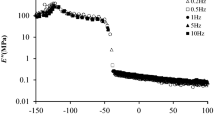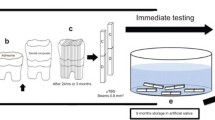Abstract
A thermogravimetric (TG) method is described for evaluating the substantivity of multi-functional polymeric materials that may be used as protective coatings for teeth. Applied to poly(butyl methacrylate) and poly(octadecyl methacrylate) film structures deposited onto model tooth surfaces from aqueous latex formulations, the method shows that while the latter polymer exhibits little substantivity, the former may be a suitable candidate material for dental-care applications.




Similar content being viewed by others
References
Hannig C, Hamkens A, Becker K, Attin R, Attin T. Erosive effects of different acids on bovine enamel: release of calcium and phosphate in vitro. Arch Oral Biol. 2005;50:541–52.
Meurman JH, Rytomaa I, Kari K, Laakso T, Murtomaa H. Salivary pH and glucose after consuming various beverages, including sugar-containing drinks. Caries Res. 1987;21:353–9.
Walters PA. Dentine hypersensitivity: a review. J Contemp Dent Pract. 2005;6(2):107–17.
Addy M. Dentine hypersensitivity: definition, prevalence, distribution and aetiology. Tooth wear and sensitivity. In: Addy M, Embery G, Edgar WM, Orchardson R, editors. Clinical advances in restorative dentistry. London: Martin Dunitz; 2000. p. 239–48.
Churchley D, Rees GD, Barbu E, Nevell TG, Tsibouklis J. Fluoropolymers as low-surface-energy tooth coatings for oral care. Int J Pharm. 2008;352(1–2):44–9.
Churchley D, Rees GD, Barbu E, Nevell TG, Tsibouklis J. Synthesis and characterization of low surface energy fluoropolymers as potential barrier coatings in oral care. J Biomed Mater Res A. 2008;84A:994–1005.
Derjaguin DV, Landau L. Theory of the stability of strongly charged lyophobic sols and the adhesion of strongly charged particles in solutions of electrolytes. Acta Physicochem URSS. 1941;14:633–62.
Verwey EJW, Overbeek JTG. Stability of colloids. Theory of the stability of lyophobic colloids. Amsterdam: Elsevier; 1948.
Tunney MM, Gorman SP, Patrick S. Infection associated with medical devices. Rev Med Microbiol. 1996;7(4):195–206.
Tsibouklis J, Stone M, Thorpe AA, Graham P, Peters V, Heerlien R, Smith JR, Green KL, Nevell TG. Preventing bacterial adhesion onto surfaces: the low-surface-energy approach. Biomaterials. 1999;20(13):1229–35.
Tsibouklis J, Stone M, Thorpe AA, Graham P, Nevell TG, Ewen RJ. Surface energy characteristics of polymer film structures: a further insight into the molecular design requirements. Langmuir. 1999;15:7076–9.
Suchanek W, Yoshimura M. Processing and properties of hydroxyapatite-based biomaterials for use as hard tissue replacement implants. Mater Res. 1998;13(1):94–117.
Smith SD, Long TE, McGrath JE. Thermogravimetric analysis of poly(alkyl methacrylates) and poly(methylmethacrylate-g-dimethyl siloxane) graft copolymers. J Polym Sci: A Polym Chem. 1994;32(9):1747–53.
Bertini F, Audisio G, Zuev VV. Investigation on the thermal degradation of poly-n-alkyl acrylates and poly-n-alkyl methacrylates (C1–C12). Polym Degrad Stab. 2005;89(2):233–9.
Awad MK. Effect of alkyl substituents on the thermal degradation of poly(alkyl methacrylate): a molecular orbital study using the ASED-MO method. Polym Degrad Stab. 1995;49(3):339–46.
Czech Z, Pelech R. Thermal degradation of poly(alkyl methacrylates). J Therm Anal Calorim. 2010;100(2):641–4.
Wang T, Dorner-Reisel A, Müller E. Thermogravimetric and thermokinetic investigation of the dehydroxylation of a hydroxyapatite powder. J Eur Ceram Soc. 2004;24:693–8.
Bianco A, Cacciotti I, Lombardi M, Montanaro L, Gusmano G. Thermal stability and sintering behaviour of hydroxyapatite nanopowders. J Therm Anal Calorim. 2007;88(1):237–43.
Dawes C. Clearance of substances from the oral cavity—implications for oral health. In: Edgar WM, O’Mullane DM, editors. Saliva and oral health. 2nd ed. London: British Dental Journal; 1996. p. 67–79.
Patel MM, Smart JD, Nevell TG, Ewen RJ, Eaton PJ, Tsibouklis J. Mucin/poly(acrylic acid) interactions: a spectroscopic investigation of mucoadhesion. Biomacromolecules. 2003;4(5):1184–90.
Author information
Authors and Affiliations
Corresponding author
Rights and permissions
About this article
Cite this article
Nielsen, B.V., Nevell, T.G., Barbu, E. et al. A thermogravimetric method for assessing the substantivity of polymer films on dentally relevant substrates. J Therm Anal Calorim 102, 121–126 (2010). https://doi.org/10.1007/s10973-010-0910-x
Received:
Accepted:
Published:
Issue Date:
DOI: https://doi.org/10.1007/s10973-010-0910-x




